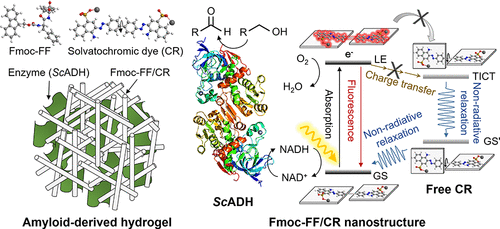当前位置:
X-MOL 学术
›
ACS Appl. Energy Mater.
›
论文详情
Our official English website, www.x-mol.net, welcomes your
feedback! (Note: you will need to create a separate account there.)
Interference of Solvatochromic Twist in Amyloid Nanostructure for Light-Driven Biocatalysis
ACS Applied Energy Materials ( IF 5.4 ) Pub Date : 2020-01-02 00:00:00 , DOI: 10.1021/acsaem.9b02303 Giyeong Son 1 , Jinhyun Kim 1 , Chan Beum Park 1
ACS Applied Energy Materials ( IF 5.4 ) Pub Date : 2020-01-02 00:00:00 , DOI: 10.1021/acsaem.9b02303 Giyeong Son 1 , Jinhyun Kim 1 , Chan Beum Park 1
Affiliation

|
Amyloid self-assembly is a powerful bottom-up approach for the synthesis of sophisticated organic nanostructures that possess fascinating structural flexibility. This study adds a dimension to the research on amyloid self-assembly by expanding its scope to the field of photobiocatalysis. We demonstrate visible-light-driven regeneration of nicotinamide adenine dinucleotide (NAD+) using solvatochromic Congo red (CR) hybridized with an amyloid-derived peptide (Fmoc-FF) nanostructure. In the course of an in situ self-assembly process of Fmoc-FF peptides, CR molecules were hybridized into a Fmoc-FF nanofiber network through π–π interactions between the nonpolar fluorenyl group of Fmoc-FF and the aromatic moieties of CR. This hybridization made CR dyes capable of photoredox catalysis because the planarization of CR induced by the Fmoc-FF degenerated the twisted intramolecular charge-transfer state of the dye; the incorporation of CR into the Fmoc-FF nanostructure increased CR’s fluorescence intensity 9 times and generated a photocurrent by 400 nA cm–2. The photocatalytic Fmoc-FF/CR hydrogel facilitated O2 reduction-coupled NAD+ regeneration under visible light. The NAD+ regeneration yield of the Fmoc-FF/CR hybrid was 5 times higher than that of free CR. Furthermore, the in situ regenerated NAD+ activated NAD+-dependent redox enzymes for alcohol oxidation; the Fmoc-FF/CR hybrid achieved a substantially high total turnover number of enzymes of 42 953, which was 5.8 times larger than that with free CR.
中文翻译:

淀粉样纳米结构中溶剂变色扭曲对光驱动生物催化的干扰
淀粉样蛋白自组装是一种强大的自下而上的方法,用于合成具有引人入胜的结构灵活性的复杂有机纳米结构。该研究通过将淀粉样蛋白自组装的范围扩展到光生物催化领域,为淀粉样自组装的研究增添了新的内容。我们展示了烟酰胺腺嘌呤二核苷酸(NAD +),使用与淀粉样蛋白衍生的肽(Fmoc-FF)纳米结构杂交的溶剂化刚果红(CR)。在Fmoc-FF肽的原位自组装过程中,CR分子通过Fmoc-FF的非极性芴基与CR的芳香族基团之间的π-π相互作用,杂交成Fmoc-FF纳米纤维网络。这种杂交使CR染料能够进行光氧化还原催化,因为Fmoc-FF诱导的CR的平面化使染料的扭曲的分子内电荷转移状态退化。将CR掺入Fmoc-FF纳米结构中可使CR的荧光强度提高9倍,并产生400 nA cm –2的光电流。光催化Fmoc-FF / CR水凝胶促进O 2还原偶联NAD +在可见光下再生。Fmoc-FF / CR杂种的NAD +再生产量比游离CR高5倍。此外,用于酒精氧化的原位再生NAD +活化的NAD +依赖性氧化还原酶。Fmoc-FF / CR杂种获得的酶的总周转率很高,为42 953,这是游离CR酶的5.8倍。
更新日期:2020-01-02
中文翻译:

淀粉样纳米结构中溶剂变色扭曲对光驱动生物催化的干扰
淀粉样蛋白自组装是一种强大的自下而上的方法,用于合成具有引人入胜的结构灵活性的复杂有机纳米结构。该研究通过将淀粉样蛋白自组装的范围扩展到光生物催化领域,为淀粉样自组装的研究增添了新的内容。我们展示了烟酰胺腺嘌呤二核苷酸(NAD +),使用与淀粉样蛋白衍生的肽(Fmoc-FF)纳米结构杂交的溶剂化刚果红(CR)。在Fmoc-FF肽的原位自组装过程中,CR分子通过Fmoc-FF的非极性芴基与CR的芳香族基团之间的π-π相互作用,杂交成Fmoc-FF纳米纤维网络。这种杂交使CR染料能够进行光氧化还原催化,因为Fmoc-FF诱导的CR的平面化使染料的扭曲的分子内电荷转移状态退化。将CR掺入Fmoc-FF纳米结构中可使CR的荧光强度提高9倍,并产生400 nA cm –2的光电流。光催化Fmoc-FF / CR水凝胶促进O 2还原偶联NAD +在可见光下再生。Fmoc-FF / CR杂种的NAD +再生产量比游离CR高5倍。此外,用于酒精氧化的原位再生NAD +活化的NAD +依赖性氧化还原酶。Fmoc-FF / CR杂种获得的酶的总周转率很高,为42 953,这是游离CR酶的5.8倍。











































 京公网安备 11010802027423号
京公网安备 11010802027423号